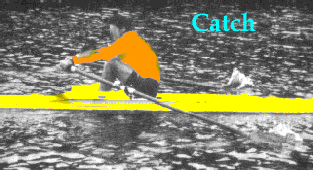![]()

![]()
This is the point of the stroke where the blade enters the water. The rower is at full compression up the slide, and tries to reach as far as possible to obtain a long stroke. When the rower is at the catch, the boat is at its most unsteady point. At this time, steadiness, and balance is key, while entering the water and changing direction quickly is of utmost importance.
After the catch, the blade is in the water and the rower drives with his/her legs against the foot stretchers to pull the blade(s) through the water and move the boat. For the first half of the drive, the rower remains upright. With the beginning of the second half (after the knees come down) the rower leans back and pulls the oar(s) in with his/her arms. The most crucial part of the drive is keeping the oar blade(s) just below the surface of the water and making the oar(s) accelerate through the water, i.e. finish faster than it began.
At the finish, the rower is leaning back and pushing down on the oar handle(s) to make it come out of the water. In order to make this easier, the rower feathers the blades. When an oar blade is feathered, it is parallel to the surface of the water.
In the first part of the recovery, the rower sits up from the release, and
moves slowly back up the slide towards the catch. Key word being
slowly. If a rower zooms back up the slide, the momentum of the rower puts
check
on the boat; it sends the boat in the other direction. That's bad.
As the rower then approaches the catch, he/she feathers the oar blade back so
that the blade is perpendicular to the surface of the water.